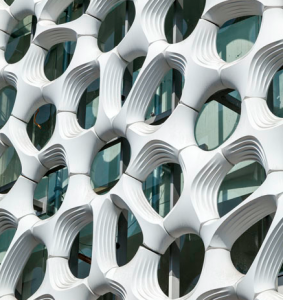Some architects are fighting air pollution with innovative projects. We’re not talking indoor air here – these architects are helping cities with serious air pollution problems deal with the atmospheric pollution.
Mexico City is a prime example – it has long been listed as among the most polluted cities in the world. Now a German company called Elegant Embellishments Ltd is fighting Mexico City’s air pollution with special architectural tile being installed on a new wing of the Dr. Manual Gea Gonzalez Hospital.
The tile, called proSolve 370e, is coated with a liquid covering that absorbs pollution. The coating, developed by U.S. company Millennium Chemicals, breaks down nitrogen oxides in the air. A primary component is titanium dioxide.
However, there’s more to it than just the coating. The tiles are designed specifically for the hospital’s surroundings, taking into account levels of sunlight, wind speed, and wind direction. The custom-designed shape of the tiles – they resemble a latticework – creates turbulence and helps distribute the pollution particles along the surface, so the coating can do its job better.
Read more about Elegant Embellishments here.
Another pollution-fighting exterior can be seen on a museum in Paris, the Jean Vouvel Musee du Quai Branly. Rather than a chemical coating, however, the museum sports a “living” wall full of grasses and shrubs that absorb toxins from the surrounding air.
The wall was designed by landscape architect Patrick Blanc, who has put these “vertical gardens” on a number of other structures around the world. Read more about him here.
Air pollution takes many forms. One of the stinkiest is the smell of urine common in some large cities where typical public facilities to handle human waste are not sufficiently available.
A designer in the Philippines, Lira Luis, is tackling that problem with a special wall made of ceramic or concrete and planted with algae and small plants that will feed on the urine. Not only will the plants reduce the smell of the liquid waste, but they will also trap carbon dioxide the way all plants do.
Read more about Luis’ project here.
Since buildings contribute so much to the world’s pollution, it’s fitting that some architects are seeking ways to use buildings to reduce pollution.


